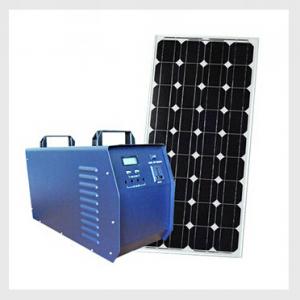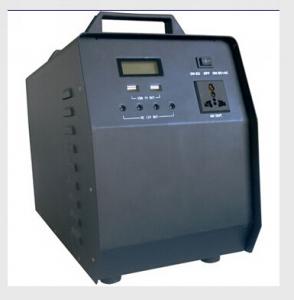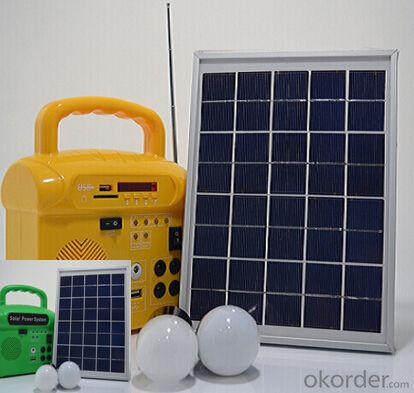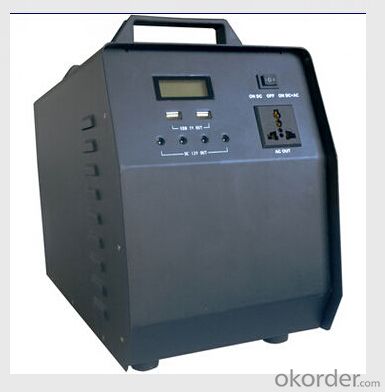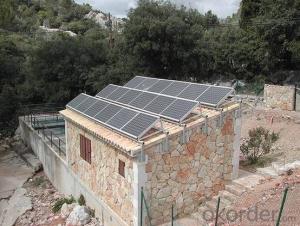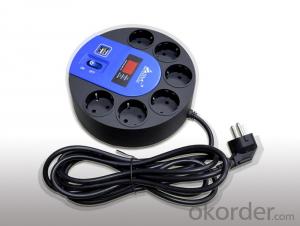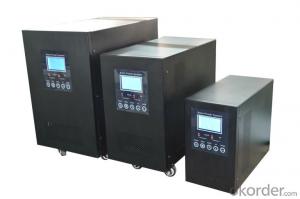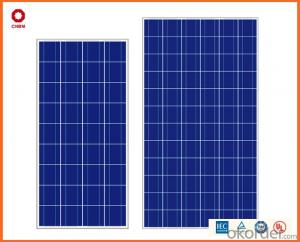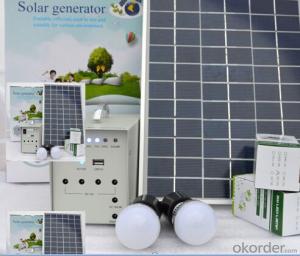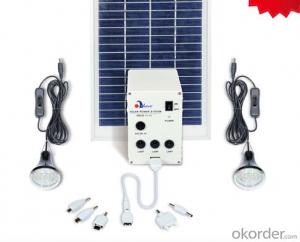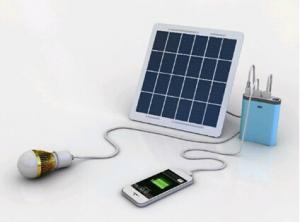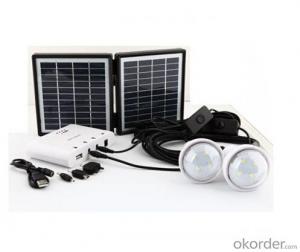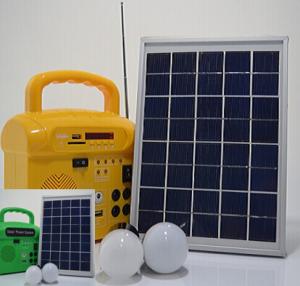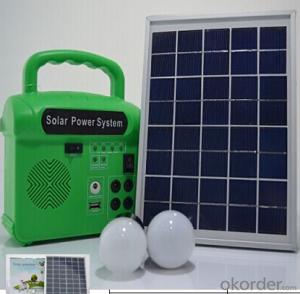Solar Energy Systems Gold Coast - CNBM Solar Home System Roof System Capacity-5w-1
- Loading Port:
- China Main Port
- Payment Terms:
- TT or LC
- Min Order Qty:
- 500 set
- Supply Capability:
- 10000 set/month
OKorder Service Pledge
OKorder Financial Service
You Might Also Like
Introduction of Solar Home System
A home solar power system is a great way to save money by reducing or even eliminating your electricity bill. In recent times the price and cost of installing a home solar power system in Australia has continued to fall, this is mostly due to an increase in demand, more efficient solar panel manufacturing techniques and advances in solar cell technology. As the price of fossil fuel generated electricity continues to rise, many more Australian homes are making the solar switch over and enjoying the true value solar energy can provide.
It is very good for indoor use where there is shortage of electricity and for outdoor activities such as picnicking, fishing and camping. It is an ideal tool for Motor Mechanics, Farm House and small shop owners such as Hairdressers, Barbers, Cobblers, Tailors and Kiosk keepers.

Working Principle of Solar Roof System
The stand alone Solar Home System is an off-grid solar system which uses batteries to store the solar energy. Stand alone solar system solutions design for those who are not able or willing to connect to electricity grid.
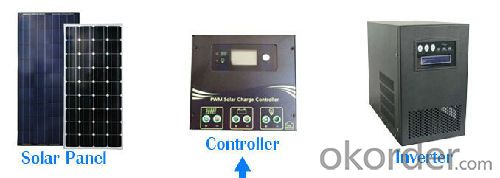
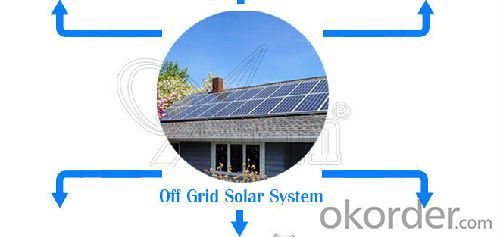

Specification of Solar Home System
Solar panel : 18V, 5W
Rechargeable battery: lead acid,12V,4Ah,maintenance-free
Lamp:led lamp, DC 12V, 20LED(1W) per lamp,lamp holder ,total 2pcs
Wire lead : 5m with DC connector
Function: over charge/discharge protection/short circuit protection
Lighting mode: constantly
Charging time: 6-8hours
Output voltage: DC 5V,DC12V,
Qutantity of carton: 3pc
Carton size: 36.5*30.5*575px
Product Features of Solar Home System
Off grid solar power system is mainly used for application with relatively-small power consumption, and the areas have no grid network coverage, or grid power is unstable or outage condition.
It’s composed of solar panels, hybrid solar inverter, battery bank, solar panel mounting racks, and other accessories required fora complete home solar power system.
The battery bank gives a stable power output to the solar inverter which converts DC to AC to power loads, and provides power backup in rainy or cloudy days.
The solar panels generate electricity at daytime and charge the battery bank.
The off grid home solar power system provides grid power bypass in case of battery power shortage when sunshine is not enough.
All the off grid home solar power system configurations are worked out by scientific calculation and design.
Advantage of Our Solar Home System
1.Safety and easy installation,Plug and play systems;
2.Good quality panel to ensure the high efficiency and long life needs;
3.Solar Automatic lighting controller :with adjustable run times, over-current protection;
4.Solar Batteries: Maintenance free, long life batteries
5.Lighting Source: LED lamp /Lantern (Fixed/Movable)
6.Flexible designs per client requests;
Terms and Conditions
1. Trade terms: FOB Shanghai
2. Payment terms: 30% T/T, balanced before shipment/ LC at sight before shipment. Actual Terms can be negotiated for big order.
3. Package: Exported standard package suitable for tough handling and sea transport.
4. Delivery: Goods to be ready within 10~30 days depending on order quantity.
5. Warranty: 10 years for solar panel, 2 years for controller/inverter/battery.
FAQ
Q: Could you introduce the background of your company?
A: We are a Group corp. with 1GW capacity in China, which is Okorder’s registered VIP Supplier, possess Financial Service from Okorder.com.
Q: Required mainly certificates (CE&IEC/TUV/RoHS)?
A: Our products are certificated by CE RoHS, IEC, ISO, TUV, UL etc.
Q: Your main exported market is?
A: Main markets of our products is: South-east Asia, Mid-east, Arica, East Europe and Latin America.
- Q: How do solar energy systems impact the demand for fossil fuels?
- Solar energy systems can have a significant impact on the demand for fossil fuels. By harnessing energy from the sun, solar systems reduce the need for traditional fossil fuel-based electricity generation. This decrease in demand for fossil fuels helps to alleviate the environmental impact associated with their extraction, combustion, and greenhouse gas emissions. Additionally, the widespread adoption of solar energy systems can promote energy independence and reduce reliance on fossil fuel imports, leading to a more sustainable and resilient energy future.
- Q: Do solar energy systems require regular panel replacements?
- No, solar energy systems do not require regular panel replacements. Solar panels are designed to be durable and can last for decades with proper maintenance.
- Q: Can solar energy systems be used for powering RVs or campers?
- Yes, solar energy systems can be used to power RVs or campers. Solar panels can be mounted on the roof of the vehicle or portable panels can be set up nearby to capture sunlight and convert it into electricity. This renewable energy source can charge the batteries of the RV or camper, providing power for lights, appliances, and other electrical needs while on the road or camping.
- Q: How do solar energy systems impact energy independence in rural areas?
- Solar energy systems have a significant positive impact on energy independence in rural areas. By harnessing the power of the sun, these systems provide a reliable and sustainable source of electricity that is independent of the traditional power grid. This reduces dependence on fossil fuels and centralized energy distribution, allowing rural communities to generate their own clean energy. Solar energy systems enable rural areas to become self-sufficient and less vulnerable to power outages, price fluctuations, and supply disruptions, thus promoting energy independence and resilience.
- Q: What is the role of solar inverters in converting DC to AC power?
- The role of solar inverters is to convert the direct current (DC) power generated by solar panels into alternating current (AC) power that can be used by electrical devices and fed into the grid.
- Q: What are the benefits of using solar energy systems?
- There are several benefits of using solar energy systems. Firstly, solar energy is a renewable source of energy, meaning it will never run out as long as the sun exists. This makes it a sustainable and environmentally friendly alternative to fossil fuels. Secondly, solar energy systems produce clean electricity, emitting zero greenhouse gases and reducing air pollution. This helps combat climate change and improves air quality, leading to better public health. Additionally, solar energy can save homeowners and businesses money on their electricity bills, as they can generate their own power and reduce reliance on the grid. Lastly, solar energy systems create job opportunities in the renewable energy sector, contributing to economic growth and development.
- Q: Can solar energy systems be used for powering electric vehicle taxi services?
- Yes, solar energy systems can be used to power electric vehicle taxi services. By installing solar panels on the roofs of taxi stations or charging stations, the energy generated can be used to charge electric vehicles. This not only reduces the carbon footprint of the taxi service but also lowers the operational costs by utilizing renewable energy.
- Q: Can a solar energy system be installed in a remote location?
- Yes, a solar energy system can be installed in a remote location. Solar panels can be set up in areas that are far from the electric grid, allowing for the generation of clean and renewable energy in remote and isolated places. These systems can provide power for various purposes, including residential, commercial, and even off-grid applications such as remote cabins, research stations, or telecommunications infrastructure. As long as there is sufficient sunlight, a solar energy system can be installed and provide a reliable source of electricity in remote locations.
- Q: Can a solar energy system be installed on a hotel or resort?
- Yes, a solar energy system can definitely be installed on a hotel or resort. In fact, many hotels and resorts around the world have already embraced solar energy and have installed solar panels on their rooftops or in their surrounding areas. Solar energy systems can provide numerous benefits to hotels and resorts, including cost savings, reduced environmental impact, and enhanced sustainability initiatives. By harnessing the power of the sun, hotels and resorts can generate clean and renewable electricity to meet a significant portion of their energy needs. This can result in substantial cost savings on electricity bills, especially in sunny regions where solar energy potential is high. Additionally, solar energy systems can help hotels and resorts to reduce their reliance on traditional energy sources, such as fossil fuels, thereby mitigating the risks associated with fluctuating energy costs. Installing solar panels on the roofs or in the open spaces of hotels and resorts is also an effective way to promote environmental sustainability. Solar energy is a clean and renewable source of power that produces no greenhouse gas emissions or air pollutants during operation. By transitioning to solar energy, hotels and resorts can significantly reduce their carbon footprint and contribute to the global efforts in combating climate change and promoting a greener future. Moreover, embracing solar energy can enhance the reputation and attract environmentally conscious guests. Many travelers today actively seek out eco-friendly accommodations that prioritize sustainability practices. By installing a solar energy system, hotels and resorts can showcase their commitment to environmental stewardship and attract a growing market of eco-conscious tourists. In summary, solar energy systems can undoubtedly be installed on hotels and resorts. They offer numerous advantages, including cost savings, reduced environmental impact, and increased appeal to eco-conscious travelers. As the world continues to prioritize renewable energy sources, hotels and resorts can play a vital role in the transition to a sustainable future by embracing solar energy.
- Q: What is the role of solar cookers in solar energy systems?
- Solar cookers play a crucial role in solar energy systems as they harness sunlight to cook food without the need for traditional fuel sources. They utilize the heat from the sun to heat and cook food, reducing the reliance on fossil fuels and minimizing environmental impact. Solar cookers are cost-effective, sustainable, and provide a clean and renewable alternative for cooking, making them an essential component of solar energy systems.
Send your message to us
Solar Energy Systems Gold Coast - CNBM Solar Home System Roof System Capacity-5w-1
- Loading Port:
- China Main Port
- Payment Terms:
- TT or LC
- Min Order Qty:
- 500 set
- Supply Capability:
- 10000 set/month
OKorder Service Pledge
OKorder Financial Service
Similar products
Hot products
Hot Searches
Related keywords
